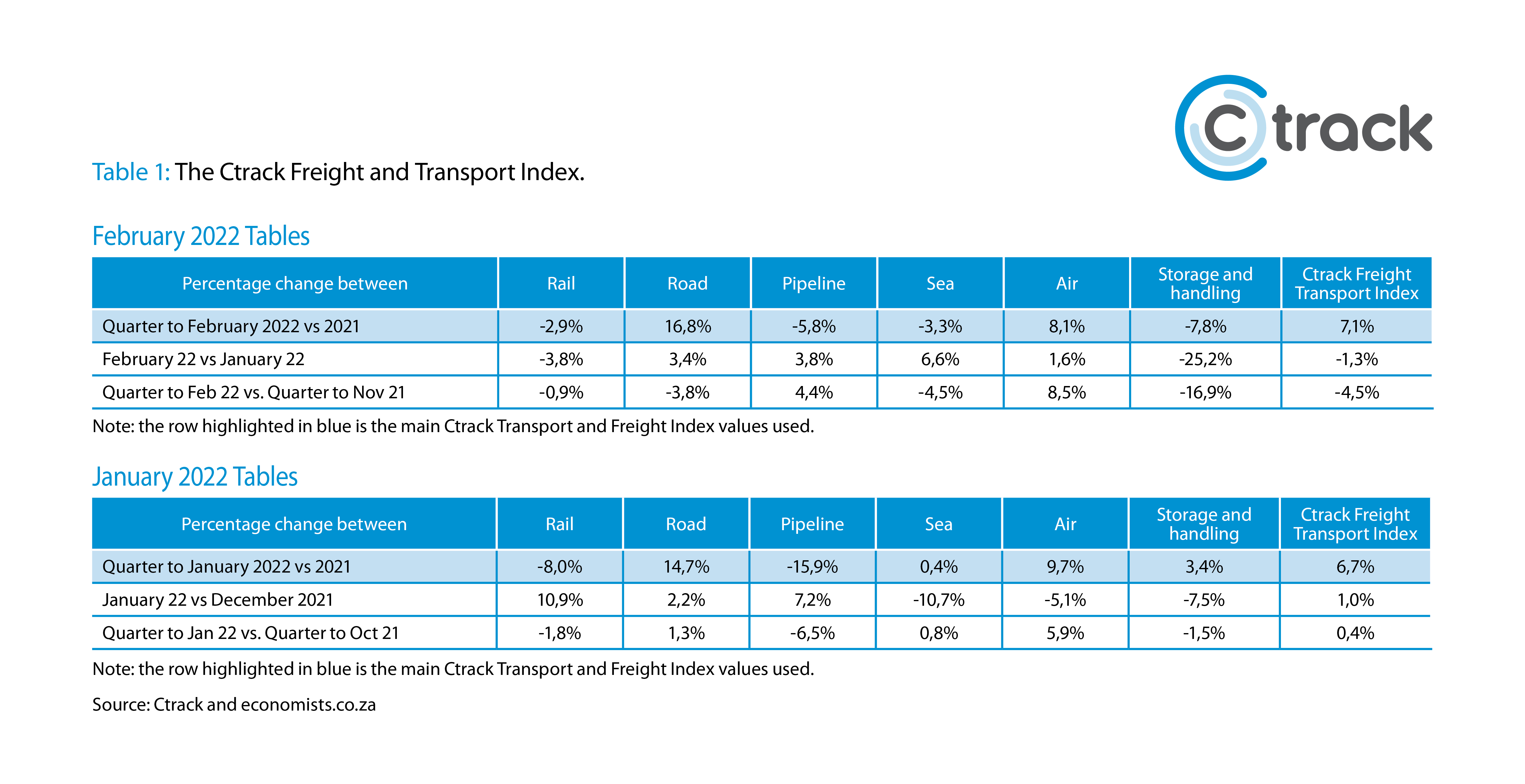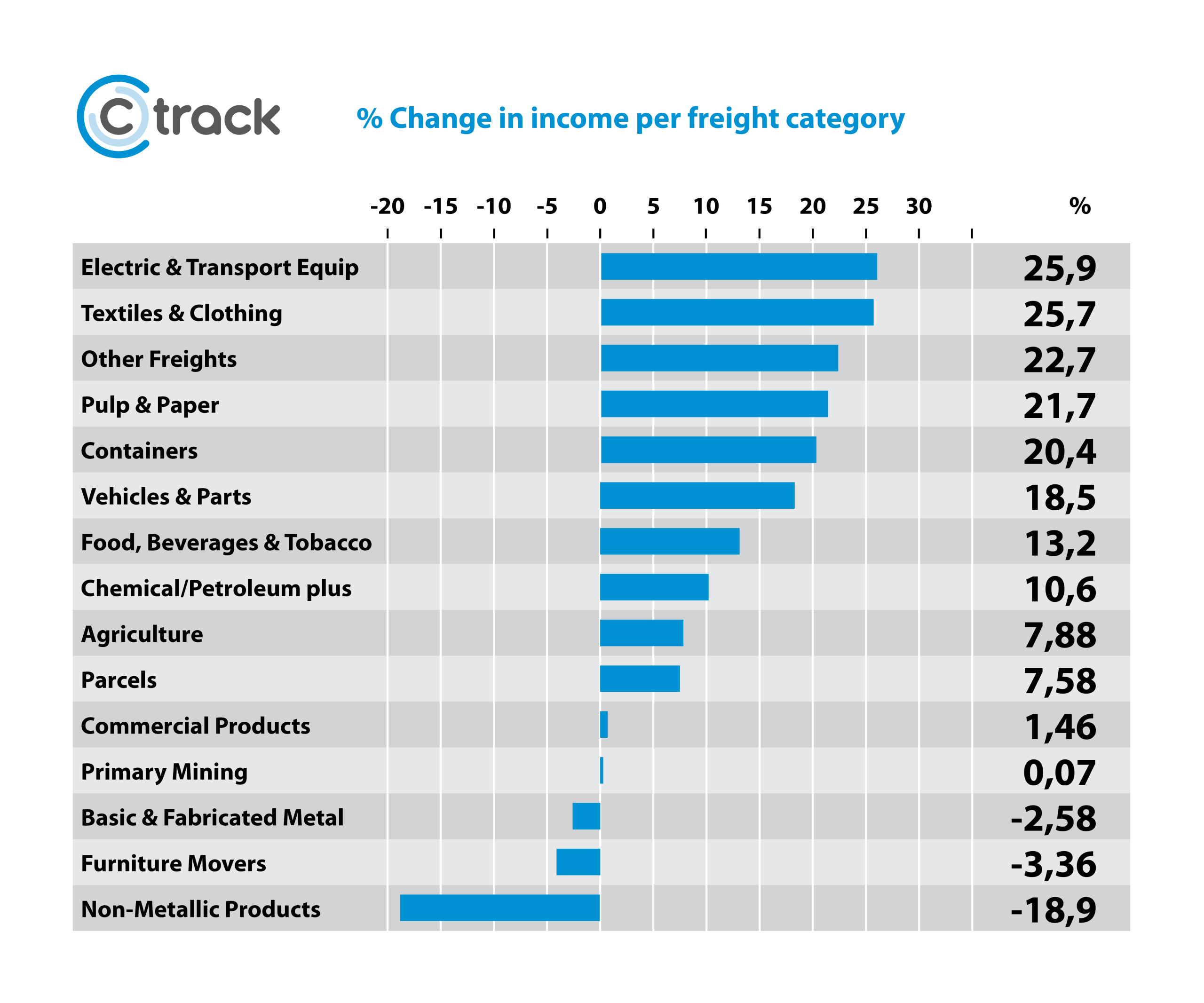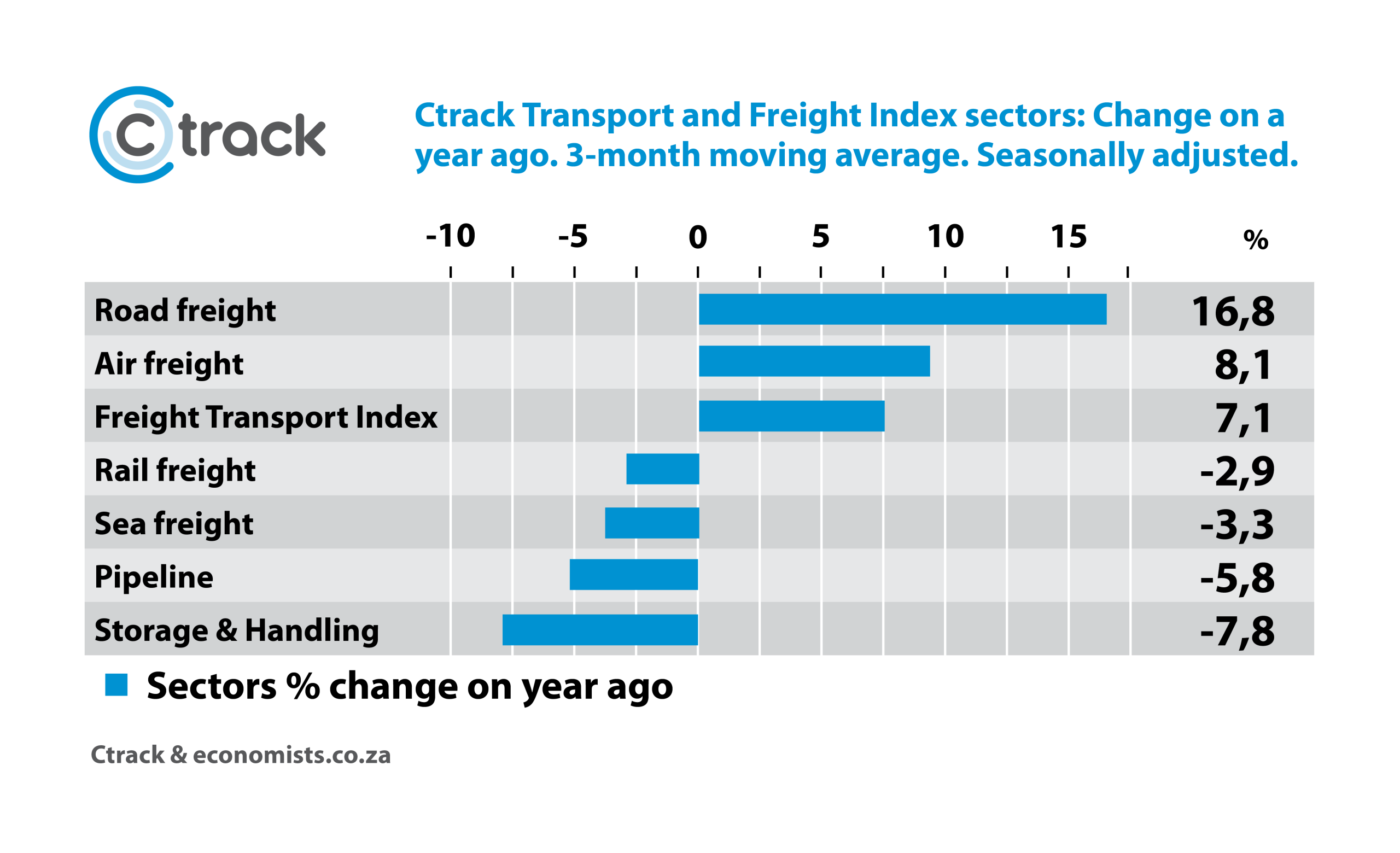Road freight is flying!
Road freight is flying!
February saw the Ctrack Transport and Freight Index record strong growth of 7,1% compared to the corresponding period last year – and road freight is flying!
Growth has continued despite the return of Covid-19 and lockdowns in certain locations such as China, as well as continued supply chain disruptions and, of course, the ongoing conflict in Ukraine. Fortunately, the global supply chain has mostly untangled itself since November 2021, and this has assisted local growth across the sectors in the last two months.
The storage sector has reported massive declines, which could be attributed to the supply chain not being able to replenish items like microchips, motor vehicles, and other complex products from across the globe. The increase in short-term interest rates – which makes storage and high inventory levels costly – has, alongside additional expected increases, also influenced the rapid decline.
Apart from air transport, international transportation has declined compared to a year ago due to the same major issues. In addition, the inability of rail transport to deliver bulk commodities to export markets has resulted in a loss of at least R40 billion for the country over the last eight months.
Even though four of the six subsectors declined, the overall Ctrack Transport and Freight Index returned significant increases. This can be attributed to road freight – as the biggest sub-sector, contributing approximately half of the Index – returning excellent growth.
Road freight grows by over 16%
Due to the ongoing collapse of certain rail corridors due to theft, road freight has gained market share, but that alone cannot be held responsible for the increase of over 16%.
To be exact, road freight increased by 16,8%, with long-distance transport increasing by between 10 and 14% depending on the specific route. However, the strength of the road logistics index seems to be in the growth of local transport operations, as opposed to international operations.
Interestingly, statistics indicate that the biggest growth has been in local road transport, which may include transport by trucks, but also by bakkies, vans, and even motorcycles.
According to Statistics South Africa (StatsSA), the fastest growing sub-sector has been land transport of electric goods and transport equipment, followed by textiles and clothing. Both of these relatively small categories increased by over 25% compared to a year ago.
The other freight category, including a mix of goods as StatsSA labels it, grew by 22,7%, while container transport grew by 20,4% and parcels by 7% compared to the same period last year.
“Ctrack prides itself on being able to offer bespoke solutions for any businesses that use vehicles or moveable assets. As such, we too have noticed an increased demand for solutions that assist in the running of local transportation or so-called last-mile delivery services. Ctrack is able to easily tailor our variety of hardware and software solutions to take the running of these operations to the next level,” says Hein Jordt, chief executive officer of Ctrack Africa.



Over 20% growth for local transport
Local transport, which includes transport directly to consumers or between local businesses, grew by more than 20%. This was a major factor in the overall road freight growth of 16%. Considering both the growth in value via StatsSA, as well as the number of vehicles crossing certain landmarks on the road network, one can identify a number of trends.
The growth in the transport sector is not just down to distance travelled but also growth in value, although this complicates direct comparisons between long-distance transport and short-distance transport such as couriers.
Data available from StatsSA excludes deliveries from providers such as Checkers Sixty60, Pick ’n Pay ASAP, Woolworths, and local pizza deliveries; these technically fall under either retail shopping or restaurants and fast food outlets. If the consumer pays the retailer and the same retailer does the delivery, then that delivery service is categorised under retail sales. However, if the consumer utilises a third party delivery service such as Uber Eats or Mr D, the transaction is recorded under transportation by a third party and falls under road transport rather than own transport.
What makes it confusing is that an online retailer often uses a subcontractor for courier services, which means the value-added is divided, as is the activity recorded by StatsSA.
All these factors make it challenging to get a true reflection of the size of the home delivery business by road transport. Since the advent of the Covid-19 pandemic, this section of road transport has more than quadrupled in size, albeit from a small base.
The growth in this industry sector can be attributed to growth in the retail environment, as can much of the increase in employment in the road transport sector.
Continued growth in home deliveries expected
The growth in home deliveries is here to stay, but the revolution is far from over. In future, we can expect to see the use of monitoring software that will enable more accurate real-time tracking by the retailer, transporter, and consumer. We can also expect to see additional security features and better planning methodologies.
Everyday shopping and, consequently, the transport sector are being transformed. Smaller vehicles and warehousing located in closer proximity to the major delivery areas will be integral to this revolution. We could even see a transformation of the restaurant industry with the removal of walk-in options or in-store dining facilities. The reality is that this sector continues to expand rapidly and probably grew by between 20 and 22% over the last year.
Airfreight has increased by 8,1% during the last year and much of this growth can also be attributed to the demand from consumers for deliveries. This includes goods ordered from international retailers, as well as local cell phone deliveries; cell phones are currently South Africa’s biggest consumer import item.
The majority of transport sub-sectors are benefitting from the revolution in home transport demand in one way or another. Just as an army marches on its stomach, stomachs at home may have helped to completely transform the road transport sub-sector.
The latest revolutionary transport trend focuses on more consumer-orientated products, but rail freight continues to play a major role in the agriculture, container, and non-metallic product sectors.
“Ctrack has a number of existing solutions in place that could easily be used to track and trace any moveable asset including trucks, cars, and motorcycles,” says Jordt. “A variety of software solutions enable fleet managers to make the most of this technology and run their fleets as efficiently as possible, no matter their purpose.”
Published by
Focus on Transport
focusmagsa




